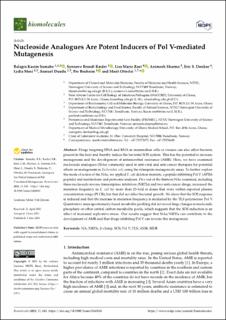| dc.contributor.author | Sumabe, Balagra Kasim | |
| dc.contributor.author | Ræder, Synnøve Brandt | |
| dc.contributor.author | Røst, Lisa M. | |
| dc.contributor.author | Sharma, Animesh | |
| dc.contributor.author | Donkor, Eric S. | |
| dc.contributor.author | Mosi, Lydia | |
| dc.contributor.author | Duodu, Samuel | |
| dc.contributor.author | Bruheim, Per | |
| dc.contributor.author | Otterlei, Marit | |
| dc.date.accessioned | 2022-10-18T07:47:07Z | |
| dc.date.available | 2022-10-18T07:47:07Z | |
| dc.date.created | 2021-06-08T13:34:26Z | |
| dc.date.issued | 2021 | |
| dc.identifier.citation | Biomolecules. 2021, 11 (6), . | en_US |
| dc.identifier.issn | 2218-273X | |
| dc.identifier.uri | https://hdl.handle.net/11250/3026532 | |
| dc.description.abstract | Drugs targeting DNA and RNA in mammalian cells or viruses can also affect bacteria present in the host and thereby induce the bacterial SOS system. This has the potential to increase mutagenesis and the development of antimicrobial resistance (AMR). Here, we have examined nucleoside analogues (NAs) commonly used in anti-viral and anti-cancer therapies for potential effects on mutagenesis in Escherichia coli, using the rifampicin mutagenicity assay. To further explore the mode of action of the NAs, we applied E. coli deletion mutants, a peptide inhibiting Pol V (APIM-peptide) and metabolome and proteome analyses. Five out of the thirteen NAs examined, including three nucleoside reverse transcriptase inhibitors (NRTIs) and two anti-cancer drugs, increased the mutation frequency in E. coli by more than 25-fold at doses that were within reported plasma concentration range (Pl.CR), but that did not affect bacterial growth. We show that the SOS response is induced and that the increase in mutation frequency is mediated by the TLS polymerase Pol V. Quantitative mass spectrometry-based metabolite profiling did not reveal large changes in nucleoside phosphate or other central carbon metabolite pools, which suggests that the SOS induction is an effect of increased replicative stress. Our results suggest that NAs/NRTIs can contribute to the development of AMR and that drugs inhibiting Pol V can reverse this mutagenesis. | en_US |
| dc.language.iso | eng | en_US |
| dc.publisher | MDPI | en_US |
| dc.relation.uri | https://www.ebi.ac.uk/pride/archive/projects/PXD025370 | |
| dc.rights | Navngivelse 4.0 Internasjonal | * |
| dc.rights.uri | http://creativecommons.org/licenses/by/4.0/deed.no | * |
| dc.title | Nucleoside Analogues Are Potent Inducers of Pol V-mediated Mutagenesis | en_US |
| dc.title.alternative | Nucleoside Analogues Are Potent Inducers of Pol V-mediated Mutagenesis | en_US |
| dc.type | Peer reviewed | en_US |
| dc.type | Journal article | en_US |
| dc.description.version | publishedVersion | en_US |
| dc.source.pagenumber | 13 | en_US |
| dc.source.volume | 11 | en_US |
| dc.source.journal | Biomolecules | en_US |
| dc.source.issue | 6 | en_US |
| dc.identifier.doi | 10.3390/biom11060843 | |
| dc.identifier.cristin | 1914539 | |
| dc.relation.project | Sigma2: NS9036K | en_US |
| dc.relation.project | Sigma2: NN9036K | en_US |
| cristin.ispublished | true | |
| cristin.fulltext | original | |
| cristin.qualitycode | 1 | |

